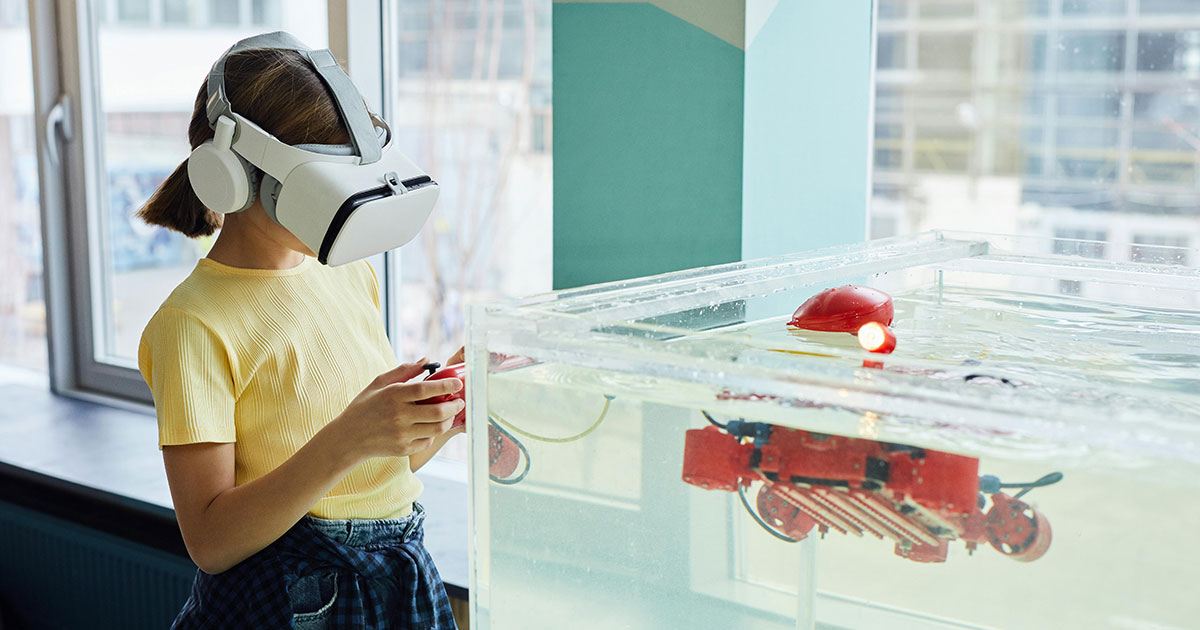
- AI/
3 Important Parenting Decisions
“There’s nothing we can do about it,” asserted a family counselor, “we have to accept that children born today will never write a word on their own. They will be completely dependent on AI. We may as well get used to it.”
I was shocked when I heard her say that. That’s not what I believe or want. In the not-too-distant future, I imagine human thinking and writing to flourish because children had the opportunity to grow their literacy and cognitive abilities to a level of maturity before they begin using AI as a tool. You could say my motto is: “Human growth alongside tech growth.” As tech evolves, we must, too. And with more potential connections in the human brain than there are atoms in the known universe, that’s a lot of potential for unprecedented human growth.
I know a college English professor who doesn’t allow his students to submit any assignment using AI…He wants them to think for themselves and he tells them just that. I asked him if he could tell when a student used AI to write an essay or a poem. He said he could. The giveaway? No distinct personality behind the words.
A friend of mine is a tour guide, mainly in Hawaii and the Pacific Northwest. If a location is new to her, she uses ChatGPT to write her blurbs which she will share on the bus with her captive audience. “With AI I can get an historical perspective with tons of interesting tidbits quickly and efficiently. Saves me so much time.” I can see that.
The first time I used AI Companion to summarize a Zoom meeting, I freaked out. Not only did it give an accurate account of everything discussed, it provided concise bullet points for next action steps. Horrified, I had to admit AI’s transcript proved a very helpful recap.
Speaking of being horrified, I recently read that EU Commission President, Ursula von der Leyen urges “embracing a life where AI is everywhere.” AI everywhere? And what kind of “life” would that be?
If that’s where we’re heading, I wonder and worry about the children and teens and college students. How do parents and teachers prepare them for when and how and why to use AI as a supportive tool while their brains, minds, and hearts develop? I think we can all agree we want them to use AI in their adult lives in ways that forward their growth and advance society’s well-being. Yet, how do we accomplish that seemingly improbable feat?
We’ve been saying to ourselves for decades now: “Tech’s a tool, after all, and kids can use screens (or AI) to further their education and enhance their gifts and talents.” Absolutely true. Yet, we see from decades of research this outcome doesn’t happen when tech time dominates life time and prevents kids from experiencing necessary developmental tasks at every stage of maturation, from early childhood throughout adolescence. In other words, when screen time eclipses other life experiences, it’s impossible for young humans to grow the required capabilities for using any type of tech wisely.
But with these three parenting decisions, children and teens could grow those required capabilities while staying human and humane in an AI world:

1. Prioritize tech time and screen content compatible with children’s and teens’ brain development, aligned with what is best for them at each age and stage.
In this way, tech time and content can actually enhance the fragile progress toward becoming self-actualizing whole adults. We know this can’t be accomplished when screen-dependence begins in early life (tragically, currently at age 6 months!). Most parents I work with do not understand how over-reliance on screens in early childhood diminish children’s chances of reaching a healthy, successful adulthood. We are beyond a crisis situation with serious deleterious effects on 15 aspects of child and teen development as I pointed out in my book, Patterns Over Time. To vulnerable brains and impressionable souls, 2-D reality quickly imprints a must-have over 3-D reality. Consequently, our innocents suffer the rest of their lives because of early screentime dependence.
Now, I fully understand parenting in a tech-obsessed world comes with incredible stresses, demands, and obstacles. And screens are all too convenient sitters and quiet makers, having been there myself as a young, single parent. And I know, too: knowledge is power.
Once parents learn about the significant connection between screen time and delayed normal developmental milestones, they discipline themselves to not use smartphones and I-pads to entertain their babies or amuse their toddlers. They energetically tap into their own creativity and enthusiastically find 3-D toys and other “loose parts” for youngster’s regular immersion in sensory experiences. And, oh my gosh, they are rewarded for their efforts, experiencing positive results quickly: Calmer children, less melt-downs, more cooperation; decreased whining, more enjoyable interactions; increased verbal abilities and focused attention. Parents gain energy and inspiration; with the exhilarating emergence of family creativity all around.
If you are searching for some light on how to ensure your child’s flourishing in this new world of AI, I invite you to consider ideas presented by a veteran writing teacher, John Warner, in his book, More than Words: How to Think About Writing in the Age of AI. Warner reiterates what I try to help parents understand: writing is thinking. “…discovering your ideas while trying to capture them on a page—and feeling—grappling with what it fundamentally means to be human. The fact that we ask students to complete so many assignments that a machine could do is a sign that something has gone very wrong with writing instruction. More Than Words calls for us to use AI as an opportunity to reckon with how we work with words—and how all of us should rethink our relationship with writing.”
We adults know first-hand writing is arduous. Choosing words to depict specific thoughts is often a slow and painful process. To those of us conditioned for needing quick results, a slow process can be intolerable. That’s one of my fears. Children who don’t learn early on to be in a slow process, won’t easily learn to stay in any slow process. Giving up when the going gets rough whether when writing or in another slow process—learning a musical instrument, for example. Easier to let AI play the piano for you. Paint your pictures for you, too; decide which configurations are more photogenic, etc. Basically, making choices that diminish our right as human creators. This terrifying thought leads me to my second consideration.
2. Prioritize real-life experiences over mediated ones.

When kids are on a screen, or even when engaging on social media, their experiences are mediated—in other words, they are not direct experiences—you know, old-fashioned face-to-face communication. Without such experiences our kids lack opportunities that limit their abilities and stimy their development. We do so much good when we choose real life over screen-directed activities. I know a mom who got tired of her middle-schooler coming home from school only to spend several hours texting her friends. Mom invited the girls over 2-3 days a week to spend time together doing homework. Over snacks, the girls had longer conversations. One day, they came up with an idea that excited them: a school blog about recycling and the environment which the principal whole-heartedly approved. Now the girls get together online and in person to work on the blog. This idea brought speakers to the school on ecology, a bake sale for a local non-profit and interest in reading and discussing the book, Creating a Better Climate Future: How you Can Start Solving Climate Change in 5 Minutes a Day. Her daughter even announced she wants to be an environmental attorney! Good things happen when kids have opportunities to develop their interest and talents in real-life experiences with family and friends. And they even use their online presence to create what is meaningful to them.
In her book, The Extinction of Experience: Being Human in a Disembodied World, Christine Rosen explores what’s at stake with our embrace of technology: less human interactions, a diminishing sense of place and an increasing inability to tolerate boredom (for adults, too!). By investigating the cultural and emotional shifts that accompany a tech world, she gives a bird’s eye view of what is happening to our humanity in general and our priorities in particular. If my sons (who are now adults) were still teens, I would have them read this book and we would discuss it in light of their lived experiences with technology. High school and college teachers, put this one on your list.
3. Always provide a context—in other words, the emperor has no clothes.

“You’re smarter than anything you see on TV.” I used to tell my sons—starting at ages 3 and 5. When they were young, I also pointed out the script writers of Sesame Street and the animators of their favorite cartons. They knew about authorship from the tangible books in front of them, but the abstract nature of screens made the makers more invisible without my help. I wanted them to understand that everything they saw on media was intentionally created. As they grew, we discussed potential intentions, as well. This higher-level understanding helped them put screen entertainment in perspective. Created by others, they too, could create something similar, or better, if they wanted.
And a lot kids, do—on Tik Tok or U-Tube, for instance. And since many platforms for our kids’ creations are created by others, that adds another perpecive to the context conversation. Family conversations can be interesting exchanges about the tech elite and their vision for humanity’s future, as well as considering the purse strings they have to fulfill it. Where does that leave everybody else? Thinking and talking about such issues becomes an imperative for today’s parents to prepare kids for the “AI everywhere” world. I truly believe that without understanding the context of who is in charge and why; without becoming context literate, kids are left adrift to the certain trajectory of becoming victims of tech elite control.
Nicolas Carr, author of The Shallows, gives food for thought about context in his latest book, Superbloom: How Technologies of Connection Tear Us Apart. Part of the book’s description reads, “From the telegraph and telephone in the 1800s to the internet and social media in our own day, the public has welcomed new communication systems. Whenever people gain more power to share information, the assumption goes, society prospers. Superbloom tells a startlingly different story. As communication becomes more mechanized and efficient, it breeds confusion more than understanding, strife more than harmony. Media technologies all too often bring out the worst in us… Carr…reveals how messaging apps strip nuance from conversation, how ‘digital crowding’ erodes empathy and triggers aggression, how online political debates narrow our minds and distort our perceptions, and how advances in AI are further blurring the already hazy line between fantasy and reality.”
He gives us a lot to think and talk about—as do the other two books. Let’s all keep thinking and talking, as we work together to figure out the AI conundrum for ourselves, and most importantly, for our children.
PATTERNS OVER TIME

An At-Home Screen-Free Activity That Keeps Your Kids Quiet and Safe—Without You!
Read more
10 VISUALIZATIONS FOR PARENTS
Release worries to discover more clam and conviction.
Tap into your mental imagery powers to parent with more ease and joy.
Center yourself in your values and parenting priorities.
Use your creative energy at full throttle.

What Calling Keeps Calling You?
Read more

Mommies: Perfect Companions for Breastfeeding Babies
Read more



